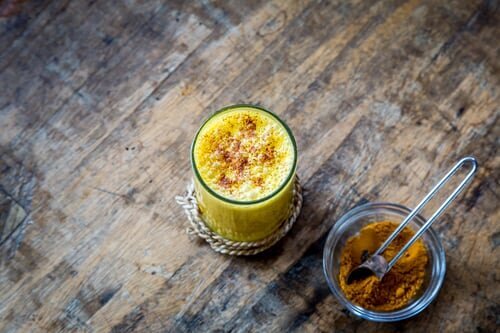Is Turmeric the Answer to Easing Pain After Exercise?
Muscle soreness that appears a day or two after exercising can affect anyone, regardless of your fitness level or ability.
Sore muscles after physical activity, otherwise known as Delayed Onset Muscle Soreness (DOMS), can occur when you change your exercise, routine, start a new exercise program or increase the intensity or duration of your regular physical activity.
DOMS is a symptom of Exercise Induced Muscle Damage or EIMD. When muscles have to work harder than they’re used to, or in a different way, it’s believed to cause microscopic damage to the muscle fibres, resulting in muscle soreness or stiffness. EIMD also leads to an inflammatory response that is associated with a reduction in the ability to generate muscle strength, as well as reduced range of motion and localised swelling.
Given muscle soreness after exercise is a common experience for many people, from beginners to elite athletes, there is a lot of interest in what can be done to reduce and prevent symptoms.
During the last decade or so, turmeric has grown in popularity as a natural health supplement that can possibly be used as an anti-inflammatory. Curcuminoids are the main ingredients of turmeric that give it a distinctive yellow colour and curcumin is the most commonly known of these curcuminoids to the point where it is often used as a generic term for the ‘active’ ingredients in turmeric.
Turmeric has long been used as a spice in cooking, but over the last few years it has been promoted (and studied) for use as a natural anti-inflammatory. While you could certainly obtain some benefit by including it in your diet, the beneficial effects of curcuminoids reduces with cooking, with the effect getting lower depending on what type of cooking method is used.
Turmeric and curcurmin are now widely available as commercially produced supplements from pharmacies and health food stores. Naturally occurring curcuminoids aren’t easily absorbed if consumed on their own, so many of the retail supplements available have been synthesised for easier absorption and are considered more potent than the natural form.
Early in 2020 a systematic review and analysis of 301 studies was conducted to determine the effectiveness of curcumin on exercise induced inflammation. It was published in the journal Nutrients (Vol 12, Iss 2, p 501 [2020]). Of the 301 available studies, only 11 met the required criteria and the total number of subjects was a little over 200 people. This is unfortunately a small number; however, the results were quite positive.
The use of curcurmin:
Reduces the subjective experience of the intensity of muscle pain
Reduces muscle damage (through the decrease of creatine kinase, an enzyme found in the heart, brain, skeletal muscle and other tissues).
Increases muscle performance
Has an anti-inflammatory effect (modulates the pro-inflammatory cytokines)
May have a slight antioxidant effect.
“In summary, the administration of curcumin at a dose between 150–1500 mg/day before and during exercise, and up until 72 hours post-exercise, improved performance by reducing EIMD (exercise induced muscle damage) and modulating the inflammation caused by physical activity. In addition, humans appear to be able to tolerate high doses of curcumin without significant side-effects.” (2)
A wide range of doses and methodologies were used, so it’s difficult to nail down the best plan for using curcumin for treatment of exercise-induced inflammation; however, there were many indicators that point to curcuminoids having a clinically significant effect with regards to reducing pain and inflammation with very little risk of side effects.
For various reasons, consumers often turn to herbal or natural supplements to use instead of, or in combination with, their prescribed medications. Some products are promoted based on wishful thinking or false promises rather than being scientifically supported, but turmeric certainly appears to show some potential and may be the source of future new anti- inflammatory treatments. At this stage, further (larger) studies are required to ascertain the best dosage form and method, but the use of this supplement is an option for most of the population to do their own experiments and see what works best for them.
As always, we recommend talking to your General Practitioner or health practitioner first before commencing any new medication, whether it is a complementary ‘over-the-counter’ or prescribed medicine or supplement. This is to make sure the new medication won’t interfere with any other medicines or supplements you take, or adversely affect any medical conditions you may have.
REFERENCES
SUN J-L, JI H-F, SHEN L. IMPACT OF COOKING ON THE ANTIOXIDANT ACTIVITY OF SPICE TURMERIC. FOOD AND NUTR RES. 2019 MAY; 63: 31 . DOI: 10.29219/FNR.V63.3451)
FERNÁNDEZ-LÁZARO, D.; MIELGO-AYUSO, J.; SECO CALVO, J.; CÓRDOVA MARTÍNEZ, A.; CABALLERO GARCÍA, A.; FERNANDEZ-LAZARO, C.I. MODULATION OF EXERCISE-INDUCED MUSCLE DAMAGE, INFLAMMATION, AND OXIDATIVE MARKERS BY CURCUMIN SUPPLEMENTATION IN A PHYSICALLY ACTIVE POPULATION: A SYSTEMATIC REVIEW. NUTRIENTS 2020; 12(2): P501. HTTPS://WWW.MDPI.COM/2072-6643/12/2/501
BANNURUR RR, OSANI MC, AL-EID F, WANG C. EFFICACY OF CURCURMIN AND BOSWELLIA FOR KNEE OSTEOARTHRITIS: SYSTEMATIC REVIEW AND META-ANALYSIS. SEMIN ARTHRITIS RHEUM. 2018 DEC; 48(3):416- 429. DOI: 10.1016/J.SEMARTHRIT.2018.03.001
AUTHOR: SCOTT MARSHALL
DISCLAIMER
THE CONTENT PROVIDED ON THIS WEBSITE IS FOR EDUCATION AND INFORMATION PURPOSES ONLY. IT IS NOT INTENDED TO REPLACE INDIVIDUAL HEALTH PROFESSIONAL CARE. READ OUR FULL DISCLAIMER HERE


